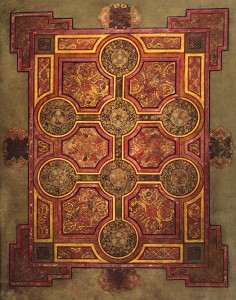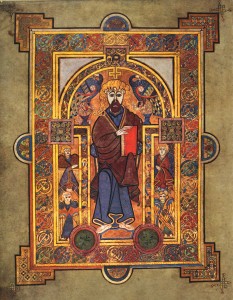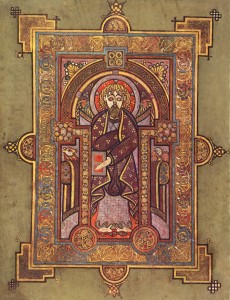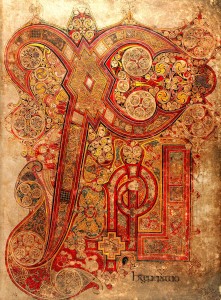Many of the design elements in our wedding, and this website, are taken from the Book of Kells and other ancient insular art style manuscripts, such as the Book of Durrow, the Lindisfarne Gospels and the Lindau Gospel.
We chose to use these symbols and illustrations because I spent a summer in Ireland very close to the town of Kells where the Book of Kells was discovered. The triple spirals (or triskelions), which we used very prominently in our design, are representative of the Holy Trinity of Father, Son and Holy Ghost, the monks that created these manuscripts used the triskelion for that meaning.
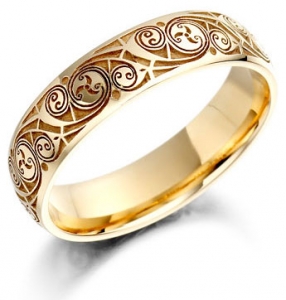 Heather and I felt the triskelion was also a good representation of our faith and enjoyed incorporating them into our wedding. Our wedding bands also use spiral designs from the Book of Kells.
Heather and I felt the triskelion was also a good representation of our faith and enjoyed incorporating them into our wedding. Our wedding bands also use spiral designs from the Book of Kells.
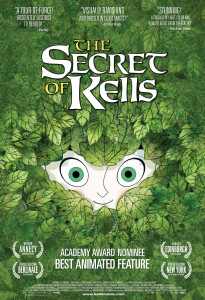 There are many web sites that describe the Book of Kells and the other manuscripts, I have included one below, but is also worth checking out the animated film The Secret of Kells which was drawn in the style of the Book of Kells and tells a fictionalized version of it’s history. It’s a very beautiful film.
There are many web sites that describe the Book of Kells and the other manuscripts, I have included one below, but is also worth checking out the animated film The Secret of Kells which was drawn in the style of the Book of Kells and tells a fictionalized version of it’s history. It’s a very beautiful film.
Below is a description of the Book of Kells written by Chris Orr:
Book of Kells – Historical Summary of Ireland’s Most Treasured Religious Artifact
Hailed by many scholars and experts as the most beautiful book in the world, the Book of Kells (sometimes known as the Book of Columba) is an extraordinarily lavish, illustrated, religious manuscript produced by Celtic monks around 800 AD. Its pages contain the four Gospels of the New Testament, accompanied by prefaces, summaries, canon tables and full page masterfully crafted illustrations. A very large and extravagant religious manuscript, such as the Book of Kells, would have been left on the high altar of the church and only taken down for the reading of the Gospel during Mass. The manuscript is now preserved and on permanent display at the Trinity College Library in Dublin, Ireland catalogued as MS 58.
History
The Book of Kells was but only one of a group of manuscripts produced during the late sixth through the ninth centuries. These manuscripts were produced in monasteries of Ireland, Scotland and northern England. Among these manuscripts were the Book of Durrow (7th century), the Durham Gospels, the Echternach Gospels, the Lindisfarne Gospels and the Lichfield Gospels, all of the 8th century. Due to the ornamentation and the similarities in artistic, script and textual styles, the Book of Kells is believed to have been produced in the late 8th or early 9th century.
There are five competing theories regarding the date and place of production of the manuscript and has been the subject of much debate. The most widely accepted theory, however, is that the Book of Kells was started in Iona, Scotland until the Vikings invaded the island in 805 AD. The manuscript was then brought to the city of Kells, Ireland, which was thought to be a Viking safe haven, where it was finished at the Abbey of Kells. Wherever it was made, the manuscript arrived in Kells in the eleventh century, where it soon took on the city’s namesake and dubbed the Book of Kells.
The next notable date in the Book of Kells’ history, was in the early eleventh century, probably 1006 or 1007, when the “chief relic of the Western world” was stolen. The manuscript was wickedly vandalized having its front gold cover, which was inlaid with precious gems, ripped from its bindings. A few months later the book was found in a ditch “under a sod.” The force of ripping the book free from its cover probably accounts for folios (pages) missing from both the beginning and the end of the Book of Kells.
The Book of Kells remained in Kells, Ireland until 1654. The book was presented to Trinity College in Dublin in 1661 where it has remained. In the nineteenth century, the book went on display to the public at the Old Library at Trinity. Over the centuries the book has been rebound several times and in 1953 the manuscript was rebound into 4 volumes and additionally some of the vellum pages were stretched where they had developed bulges. The library usually displays two of the four volumes at a time, one showing a major illustration and one showing pages of text.
Contents
The Book of Kells contains the four gospels of Matthew, Mark, Luke and John through John 17:13 as well as several additions. The remainder of John and other prefatory material were perhaps lost when the book was stolen and vandalized in the eleventh century. The existing prefatory additions include the Breves Causae (Gospel summaries), the Eusubain Canon Tables (cross reference sections and indices), and the Argumenta (short bios of the Evangelists) of the gospels. The canon tables in the Book of Kells are virtually unusable because the scribe had them organized very confusingly, and in addition, the chapter numbers were never inserted into the text pages in the margins, making it nearly impossible to find the referenced material. It is not known why this was the case, although there are a few theories.
The Book of Kells comprises the four gospels of the New Testament based on the Vulgate (Latin version of the Bible prepared chiefly by Saint Jerome in the 4th century AD and used as the authorized version of the Roman Catholic Church); however it doesn’t contain an exact replica of the Vulgate. There are variations of the Vulgate where Old Latin text is substituted for Jerome’s writing. The text of the Book of Kells is written in insular majuscule (a medieval script system used in Ireland), where it is accompanied by lavishly painted illustrations. The book is made up of 340 vellum (calfskin) folios, which are part of a larger sheet, termed bifolios, when folded in half form two folios.
The manuscript was designed in such a way that each of the four gospels had a full folio, lavish introductory illustration. Additionally, the opening few words of each gospel were so extravagantly illustrated, that the text itself was practically unintelligible. The borders of the page as well as the letters themselves were further decorated with elaborate spirals and knotwork, many of them zoomorphic.
Two of the most celebrated illustrations in the Book of Kells are the chi-rho illustration and the image of the Virgin (Madonna) and Child. The Greek letters “chi” and “rho” were often used in medieval manuscripts to abbreviate the word “Christ.”
The chi-rho illustration page is elaborately decorated with swirling knotwork, and within this lavish decoration there are hidden animals and insects, as well as three angels. This illustrative page (folio 34), prefaces Matthew 1:18, where the story of Christ’s life begins. The Virgin and Child image (folio 7v), is prefatory to the Breves Causae of Matthew, and faces the first page of text. The image of the Virgin and Child is believed to be the first representation of the Virgin in Western manuscript.
The elaborate illustrations in the Book of Kells are seen on every page with the exception of two. Throughout the text are found decorated initials and small animal and human forms often twisted into very intricate knotwork. The intricate knotwork and associated interweaving designs found in the Book of Kells are also found in the metalwork and stone carvings of the period.
The elaborate Celtic artwork found in the Book of Kells, other similar religious manuscripts, as well as the metal and stone illustrations found in this period, are indeed very evident in today’s society. We need only look to the jewelry and tattoo industries. There are literally thousands of Celtic inspired designs showcased in these mediums.
It is no wonder that given its history, the Book of Kells is Ireland’s most treasured religious artifact.
References:
“Book of Kells.” New World Encyclopedia . 3 April 2008, 18:33 UTC. 14 Oct 2011, 14:21

